Mikhail Lomonosov
Mikhail Vasilyevich Lomonosov (/ˌlɒməˈnɒsɒf/;[1] Russian: Михаи́л (Михáйло) Васи́льевич Ломоно́сов, IPA: [mʲɪxɐˈil vɐˈsʲilʲjɪvʲɪtɕ ləmɐˈnosəf] (![]()
Mikhail Lomonosov | |
|---|---|
.jpg) Portrait by G. Prenner, 1787 | |
| Born | Mikhaylo Vasilyevich Lomonosov 19 November 1711 |
| Died | 15 April 1765 (aged 53) |
| Nationality | Russian |
| Alma mater | Slavic Greek Latin Academy St. Petersburg Academy University of Marburg |
| Spouse(s) | Elizabeth Christine Zilch |
| Scientific career | |
| Fields | Natural science, chemistry, physics, mineralogy, history, philology, poetry, optics |
| Institutions | St. Petersburg Academy |
| Academic advisors | Christian Wolff |
| Signature | |
Early life and family
Lomonosov was born in the village of Mishaninskaya (later renamed Lomonosovo in his honor) in Archangelgorod Governorate, on an island not far from Kholmogory, in the far north of Russia.[2] His father, Vasily Dorofeyevich Lomonosov, was a prosperous peasant fisherman turned ship owner, who amassed a small fortune transporting goods from Arkhangelsk to Pustozyorsk, Solovki, Kola, and Lapland.[2] Lomonosov's mother was Vasily's first wife, a deacon's daughter, Elena Ivanovna Sivkova.[3]
He remained at Denisovka until he was ten, when his father decided that he was old enough to participate in his business ventures, and Lomonosov began accompanying Vasily on trading missions.[3]
Learning was young Lomonosov's passion, however, not business. The boy's thirst for knowledge was insatiable. Lomonosov had been taught to read as a boy by his neighbor Ivan Shubny, and he spent every spare moment with his books.[3] He continued his studies with the village deacon, S.N. Sabelnikov, but for many years the only books he had access to were religious texts. When he was fourteen, Lomonosov was given copies of Meletius Smotrytsky's Modern Church Slavonic (a grammar book) and Leonty Magnitsky's Arithmetic.[4] Lomonosov was a Russian orthodox all his life, but had close encounters with Old Believers schism in early youth and later in life he became a deist.[5][6]
In 1724, his father married for the third and final time. Lomonosov and his stepmother Irina had an acrimonious relationship. Unhappy at home and intent on obtaining a higher education, which Lomonosov could not receive in Mishaninskaya, he was determined to leave the village.[7]
Education in Moscow and Kiev

In 1730, at nineteen, Lomonosov went to Moscow on foot, because he was determined to "study sciences".[7] Shortly after arrival, he admitted into the Slavic Greek Latin Academy by falsely claiming to be a son of a Kholmogory nobleman.[8] In 1734 that initial falsehood as well as another lie for him to be son of a priest nearly got him expelled from the academy but the investigation ended without severe consequences.[9]
Lomonosov lived on three kopecks a day, eating only black bread and kvass, but he made rapid progress scholastically.[10] It is believed that in 1735, after three years in Moscow he was sent to Kiev to study for short period at the Kiev-Mohila Academy. He quickly became dissatisfied with the education he was receiving there, and returned to Moscow to resume his studies there.[10] In five years Lomonosov completed a twelve-year study course and in 1736, among 12 best graduates, was awarded a scholarship at the St. Petersburg Academy.[11] He plunged into his studies and was rewarded with a four-year grant to study abroad, in Germany, first at the University of Marburg and then in Freiberg.[12]
Education abroad
The University of Marburg was among Europe's most important universities in the mid-18th century due to the presence of the philosopher Christian Wolff, a prominent figure of the German Enlightenment. Lomonosov became one of Wolff's students while at Marburg from November 1736 to July 1739. Both philosophically and as a science administrator, this connection would be the most influential of Lomonosov's life. In 1739–1740 he studied mineralogy, metallurgy, and mining at Bergrat Johann Friedrich Henckel's laboratory in Freiberg, Saxony; there he intensified his studies of German literature.[13]

Lomonosov quickly mastered the German language, and in addition to philosophy, seriously studied chemistry, discovered the works of 17th century Irish theologian and natural philosopher, Robert Boyle, and even began writing poetry. He also developed an interest in German literature. He is said to have especially admired Günther. His Ode on the Taking of Khotin from the Turks, composed in 1739, attracted a great deal of attention in Saint Petersburg.[13] Contrary to his adoration for Wolff, Lomonosov went into fierce disputes with Henckel over the training and education courses he and his two compatriot students were getting in Freiberg as well as over very limited financial support which Henckel was instructed to provide to the Russians after numerous debts they made in Marburg. As the result, Lomonosov left Freiberg without permission and wandered for quite a while over Germany and Holland unsuccessfully trying to get a permission from Russian envoys to return to the St.Petersburg Academy.
During his residence in Marburg, Lomonosov boarded with Catharina Zilch, a brewer's widow.[14] He fell in love with Catharina's daughter Elizabeth Christine Zilch. They were married in June 1740.[15] Lomonosov found it extremely difficult to maintain his growing family on the scanty and irregular allowance granted him by the Russian Academy of Sciences. As his circumstances became desperate, he resolved and got permission to return to Saint Petersburg.[13]
Return to Russia
.jpg)
Lomonosov returned to Russia in June 1741, after being abroad 4 years and 8 months. A year later he was named an Adjunct of the Russian Academy of Science in the physics department.[13] In May 1743, Lomonosov was accused, arrested, and held under house arrest for eight months, after he supposedly insulted various people associated with the Academy. He was released and pardoned in January 1744 after apologising to all involved.[13]
Lomonosov was made a full member of the Academy, and named Professor of chemistry, in 1745.[13] He established the Academy's first chemistry laboratory.[16] Eager to improve Russia's educational system, in 1755, Lomonosov joined his patron Count Ivan Shuvalov in founding Moscow University.[16]
In 1760, he was elected a Foreign Member of the Royal Swedish Academy of Sciences. In 1764, he was elected Foreign Member of the Academy of Sciences of the Institute of Bologna[17] In 1764, Lomonosov was appointed to the position of the State Councillor which was of Rank V in the Russian Empire's Table of Ranks. He died on 4 April (o.s.), 1765 in Saint Petersburg. He is widely and deservingly regarded as the "Father of Russian Science",[18] though many of his scientific accomplishments were relatively unknown outside Russia until long after his death and gained proper appreciation only in late 19th and, especially, in 20th centuries.
Physicist

In 1756, Lomonosov tried to replicate Robert Boyle's experiment of 1673.[19] He concluded that the commonly accepted phlogiston theory was false. Anticipating the discoveries of Antoine Lavoisier, he wrote in his diary: "Today I made an experiment in hermetic glass vessels in order to determine whether the mass of metals increases from the action of pure heat. The experiments – of which I append the record in 13 pages – demonstrated that the famous Robert Boyle was deluded, for without access of air from outside the mass of the burnt metal remains the same".
That is the Law of Mass Conservation in chemical reaction, which was well-known today as "in a chemical reaction, the mass of reactants is equal to the mass of the products." Lomonosov, together with Lavoisier, is regarded as the one who discovered the law of mass conservation.[20]
He stated that all matter is composed of corpuscles – molecules that are "collections" of elements – atoms. In his dissertation "Elements of Mathematical Chemistry" (1741, unfinished), the scientist gives the following definition: "An element is a part of a body that does not consist of any other smaller and different bodies ... corpuscle is a collection of elements forming one small mass."[21] In a later study (1748), he uses term "atom" instead of "element", and "particula" (particle) or "molecule" instead of "corpuscle".
He regarded heat as a form of motion, suggested the wave theory of light, contributed to the formulation of the kinetic theory of gases, and stated the idea of conservation of matter in the following words: "All changes in nature are such that inasmuch is taken from one object insomuch is added to another. So, if the amount of matter decreases in one place, it increases elsewhere. This universal law of nature embraces laws of motion as well, for an object moving others by its own force in fact imparts to another object the force it loses" (first articulated in a letter to Leonhard Euler dated 5 July 1748, rephrased and published in Lomonosov's dissertation "Reflexion on the solidity and fluidity of bodies", 1760).[22]
Astronomer
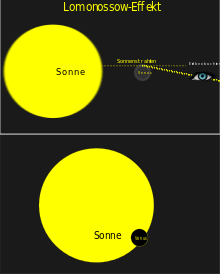
Lomonosov was the first to discover and appreciate the atmosphere of Venus during his observation of the transit of Venus of 1761 in a small observatory near his house in St Petersburg.[13][23]
In June 2012 a group of astronomers carried out experimental reconstruction of Lomonosov's discovery of Venusian atmosphere with antique refractors during the transit of Venus (5–6 June 2012).[24] They concluded that Lomonosov's telescope was fully adequate to the task of detecting the arc of light around Venus off the Sun's disc during ingress or egress if proper experimental techniques as described by Lomonosov in his 1761 paper[25] are employed.[26]

In 1762, Lomonosov presented an improved design of a reflecting telescope to the Russian Academy of Sciences forum. His telescope had its primary mirror adjusted at an angle of four degrees to the telescope's axis. This made the image focus at the side of the telescope tube, where the observer could view the image with an eyepiece without blocking the image. However, this invention was not published until 1827, so this type of telescope has become associated with a similar design by William Herschel, the Herschelian telescope.[27]
Chemist and geologist
In 1759, with his collaborator, academician Joseph Adam Braun, Lomonosov was the first person to record the freezing of mercury and to carry out initial experiments with it.[28] Believing that nature is subject to regular and continuous evolution, he demonstrated the organic origin of soil, peat, coal, petroleum and amber. In 1745, he published a catalogue of over 3,000 minerals, and in 1760, he explained the formation of icebergs.[13]
In 1763, he published On The Strata of the Earth – his most significant geological work.[29]
Geographer
Lomonosov's observation of iceberg formation led into his pioneering work in geography. Lomonosov got close to the theory of continental drift,[30] theoretically predicted the existence of Antarctica (he argued that icebergs of the South Ocean could be formed only on a dry land covered with ice),[31] and invented sea tools which made writing and calculating directions and distances easier. In 1764, he organized an expedition (led by Admiral Vasili Chichagov) to find the Northeast Passage between the Atlantic and Pacific oceans by sailing along the northern coast of Siberia.[13]
Mosaicist

Lomonosov was proud to restore the ancient art of mosaics. In 1754, in his letter to Leonhard Euler, he wrote that his three years of experiments on the effects of chemistry of minerals on their colour led to his deep involvement in the mosaic art. In 1763, he set up a glass factory that produced the first stained glass mosaics outside of Italy. There were forty mosaics attributed to Lomonosov, with only twenty-four surviving to the present day. Among the best is the portrait of Peter the Great and the Battle of Poltava, measuring 4.8 by 6.4 metres (16 ft × 21 ft).[32][33][34]
Grammarian, poet, historian
In 1755 Lomonosov wrote a grammar that reformed the Russian literary language by combining Old Church Slavonic with the vernacular tongue. To further his literary theories, he wrote more than 20 solemn ceremonial odes, notably the Evening Meditation on God's Grandeur. He applied an idiosyncratic theory to his later poems – tender subjects needed words containing the front vowel sounds E, I, Y and U, whereas things that may cause fear (like "anger", "envy", "pain" and "sorrow") needed words with back vowel sounds O, U and Y. That was a version of what is now called sound symbolism.
In 1760 Lomonosov published a History of Russia.[35][36] In addition, he attempted to write a grand epic about Peter the Great, to be based on the Aeneid by Vergil, but he died before he could finish it.[37]
Legacy
His granddaughter Sophia Konstantinova (1769–1844) married Russian military hero and statesman General Nikolay Raevsky. His great-granddaughter was Princess Maria (Raevskaya) Volkonskaya, the wife of the Decembrist Prince Sergei Volkonsky.[38]
The city of Lomonosov, Russia (former Oranienbaum, Russia from 1710–1948), and a lunar crater bear his name, as does a crater on Mars and the asteroid 1379 Lomonosowa. A Russian satellite launched in 2016 was named Mikhailo Lomonosov (satellite) after him. The Imperial Porcelain Factory, Saint Petersburg was renamed after him from 1925 to 2005. In 1948, the underwater Lomonosov Ridge in the Arctic Ocean was named in his honor.
Moscow's Domodedovo airport is officially named after Lomonosov.
The Lomonosov Gold Medal was established in 1959 and is awarded annually by the Russian Academy of Sciences to a Russian and a foreign scientist.[39].
Lomonosovskaya Station on the Nevsko-Vasileostrovskaya Line of the Saint Petersburg Metro is named after him. It was opened in 1970.
The street "Lomonosova iela" in the Maskavas Forštate district of Riga is named in honor of Lomonosov. During the Soviet era a main street in Tallinn, Estonia, was named in his honor as "Lomonossovi M.", but from 1991 it was renamed Gonsiori after Jakob Johann Gonsior, a 19th-century alderman and lawyer.[40]
On 19 November 2011, Google celebrated his 300th birthday with a Google Doodle.[41]
A great number of different stamps was issued in honor of Lomonosov throughout the years: Mikhail Lomonosov and building of the Academy in Leningrad stamp of 1925[42], stamps depicting Lomonosov issued in 1949[43], in 1956[44] and in 1961[45], a 275th Birth Anniversary of M.V.Lomonosov stamp of 1986[46], a History of Russia (Ekaterina II) stamp depicting Lomonosov and his study room talking to the queen that was issued in 2004[47], three 300th Anniversary of the Birth of M.V.Lomonosov stamps were issued in 2011 [48][49][50].
- Postage stamps of USSR and Russia
 1955
1955_and_the_Kunstkamera_in_Saint_Petersburg).jpg) 1956
1956 1986
1986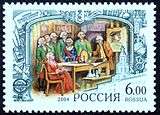 2004
2004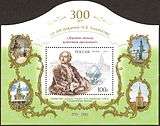 2011
2011 1925 год
1925 год 1945 год
1945 год 1961 год
1961 год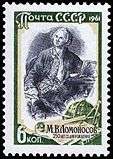 1961 год
1961 год 1961 год
1961 год
The Akademik Lomonosov, the first of a series of Russian floating nuclear power stations, is named for him. It is expected to be operational at Pevek, Chukotka in September 2019.[51][52]
Moscow State University, founded by him in 1755, was renamed M. V. Lomonosov Moscow State University in 1940, while celebrating its 185th anniversary.[53] There are also Moscow Institute of Mechanics and Electrical Engineering M.V. Lomonosov (Lomonosov Institute), Lomonosov Institute of Geochemistry, Mineralogy and Petrography, USSR Academy of Sciences in Moscow, Lomonosov Northern (Arctic) Federal University, Odessa Technological Institute of Food Industry n.a. M.V. Lomonosov, Moscow State University of Fine Chemical Technologies n.a. M.V. Lomonosov, and several other school in Russia and Kazakhstan [54].
On 19 November 1986, on the 275th anniversary of the birth of M.V. Lomonosov, the USSR State Bank issued a 1 ruble commemorative coin from a copper-nickel alloy.[55]
- Commemorative coins of Russia depicting Lomonosov
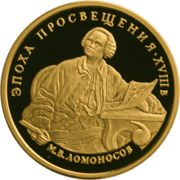 1992, the first commemorative coin of the Central Bank of the Russian Federation with a face value of 100 rubles. Gold
1992, the first commemorative coin of the Central Bank of the Russian Federation with a face value of 100 rubles. Gold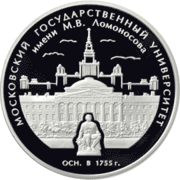 2005, 3 rubles, silver. 250th anniversary of the founding of Moscow State University
2005, 3 rubles, silver. 250th anniversary of the founding of Moscow State University 2011, 2 rubles, silver. On the occasion of the 300th birthday
2011, 2 rubles, silver. On the occasion of the 300th birthday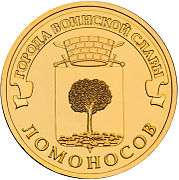 2015, commemorative coin, 10 rubles
2015, commemorative coin, 10 rubles
Works
- English translations
- Lomonosov, Mikhail (1767). A Chronological Abridgement of the Russian History. Translated by J.G.A.F. for T. Snelling. [London, Printed for T. Snelling].
- Lomonosov, Mikhail (1966). Panegyric to the Sovereign Emperor, Peter the Great. Translated by Ronald Hingley in Marc Raeff, ed. Russian Intellectual History: An Anthology. Prometheus Books. ISBN 978-0391009059.
- Lomonosov, Mikhail (1970). Mikhail Vasil'evich Lomonosov on the Corpuscular Theory. Translated by Henry M. Leicester. Harvard University Press. ISBN 978-0674574205.
- Lomonosov, Mikhail (2012). The Appearance of Venus on the Sun, Observed at the St.Petersburg Imperial Academy of Sciences on May 26, 1761. Translated by Vladimir Shiltsev in "Lomonosov's Discovery of Venus Atmosphere in 1761: English Translation of Original Publication with Commentaries". arXiv:1206.3489.
- Lomonosov, Mikhail (2012). On the Strata of the Earth. Translation and commentary by S.M. Rowland and S. Korolev. The Geological Society of America, Special Paper 485. ISBN 978-0-8137-2485-0.
- Lomonosov, Mikhail (2017). Oratio De Meteoris Vi Electrica Ortis – Discourse on Atmospheric Phenomena Originating from Electrical Force (1753). Translation and commentary by Vladimir Shiltsev. arXiv:1709.08847.
- Lomonosov, Mikhail (2018). Meditations on Solidity and Fluidity of Bodies (1760). Translation and commentary by Vladimir Shiltsev. arXiv:1801.00909.
- German translations
- Lomonossow, Michail (1961). Michail Wassiljewitsch Lomonossow. Ausgewählte Schriften in zwei Bänden. Berlin-Akademie Verlag.
- Lomonosov, Michail (2015). Erste Grundlagen Der Metallurgie Oder Des Huttenwesens (1763). Herausgegeben und kommentiert von Friedrich Naumann. Walter de Gruyter. ISBN 978-3110424072.
- Lomonosov, Michail (2017). Naumann, Friedrich (ed.). Schriften zur Geologie und zum Berg- und Hüttenwesen (1742–1765). Herausgegeben und kommentiert von Friedrich Naumann. Walter de Gruyter. doi:10.1515/9783110424065. ISBN 978-3-11-042406-5.
See also
References
Citations
- "Lomonosov". Random House Webster's Unabridged Dictionary.
- Menshutkin 1952, p. 11.
- Menshutkin 1952, p. 12.
- Menshutkin 1952, p. 13.
- Galina Evgenʹevna Pavlova; Aleksandr Sergeevich Fedorov (1980). Mikhail Vasilievich Lomonosov: his life and work. Mir. p. 161.
The atheistic direction of Lomonosov's scientific and artistic creativity was not always consistent. His world outlook, just as that of many other representatives of the age of enlightenment, possessed elements of deism according to which God, having created the universe, assumed no control over its development which was governed by the laws of nature. Lomonosov's deism was no chance factor. As Karl Marx aptly put it, deism was the most convenient and easiest way for many materialists of the 17th–18th centuries to abandon religion.
- Andrew Kahn (2008). Pushkin's Lyric Intelligence. Oxford University Press. p. 130. ISBN 9780191552939.
No atheistic conclusions spring from 'The Orb of Day has Set' to reverse Lomonosov's deism, but the poem still intrudes a painful gap between man and nature.
- Menshutkin 1952, p. 15.
- Menshutkin 1952, p. 16.
- Menshutkin 1952, p. 20.
- Menshutkin 1952, p. 17.
- Menshutkin 1952, p. 23.
- Menshutkin 1952, p. 24.
- Menshutkin 1952.
- Pavlova, Galina E., and Fedorov, Aleksandr S. Mikhail Vasilievich Lomonosov: His Life and Work (English Translation). Mir: Moscow, 1980.
- Pavlova, Galina E., and Fedorov, Aleksandr S. Mikhail Vasilievich Lomonosov: His Life and Work (English Translation). Mir: Moscow, 1980. ISBN 0-8285-2895-0, ISBN 978-0-8285-2895-5
- Cornwell, Neil and Christian, Nicole. Reference Guide to Russian Literature, p. 514. Taylor & Francis: London, 1998
- R. Crease and V. Shiltsev, "Mikhail Lomonosov (1711–1765): Scientist in Politically Turbulent Times" in Il Nuovo Saggiatore, vol. 33, issue 5–6 (2017), pp. 43–56 https://www.ilnuovosaggiatore.sif.it/issue/54 Archived 30 January 2018 at the Wayback Machine
- V. Shiltsev, "Mikhail Lomonosov and the dawn of Russian science", Physics Today (February 2012), vol. 65, http://physicstoday.scitation.org/doi/10.1063/PT.3.1438
- Menshutkin 1952, p. 120.
- Pomper, Philip (October 1962). "Lomonosov and the Discovery of the Law of the Conservation of Matter in Chemical Transformations". Ambix. 10 (3): 119–127. doi:10.1179/amb.1962.10.3.119.
- Lomonosov, Mikhail Vasil'evich (1959). Mikhail Vasil'evich Lomonosov on the Corpuscular Theory. Translated by Leicester, Henry M. Cambridge, Massachusetts: Harvard University Press. pp. 56–57.
- Pismen, Len (2018). The Swings of Science: From Complexity to Simplicity and Back. Springer. p. 41. ISBN 978-3-319-99777-3.
- Shiltsev, Vladimir (March 2014). "The 1761 Discovery of Venus' Atmosphere: Lomonosov and Others". Journal of Astronomical History and Heritage. 17 (1): 85–112. Bibcode:2014JAHH...17...85S.
- A.Koukarine, et al., "Experimental Reconstruction of Lomonosov's Discovery of Venus's Atmosphere with Antique Refractors During the 2012 Transit of Venus" (2012)
- V. Shiltsev, "Lomonosov's Discovery of Venus Atmosphere in 1761: English Translation of Original Publication with Commentaries" (2012)
- V. Shiltsev, I. Nesterenko, and R. Rosenfeld, "Replicating the discovery of Venus's atmosphere", Physics Today, Feb. 2013 / Volume 66, Issue 2, p. 64 "Archived copy". Archived from the original on 4 July 2013. Retrieved 15 May 2013.CS1 maint: archived copy as title (link)
- "On an optic pipe improvement" – Lomonosov M.V. Selected works in two volumes. Volume I: Natural sciences and philosophy. Moscow: Nauka (Science) publishing house, 1986 (in Russian). Name in Russian: «Об усовершенствовании зрительных труб» – М.В. Ломоносов. Избранные произведения. В двух томах. Т. 1. Естественные науки и философия. М.: Наука. 1986
- Lomonosov M.V. Meditations on Solidity and Fluidity of Bodies (1760) / translation and commentary by Vladimir Shiltsev (2018); https://arxiv.org/abs/1801.00909
- Lomonosov M.V. On the strata of the Earth: a translation of "O sloiakh zemnykh" / translated by S.M. Rowland, S. Korolev. Boulder: Geological Soc. of America, 2012. 41 p. (Special paper; 485)
- Life and Death of Alfred Wegener Archived 11 January 2008 at the Wayback Machine by Alexey Fedorchuk (in Russian)
- Eduard Belcher Prediction of Antarctica by Lomonosov (in Russian)
- Elena Lavrenova. "Lomonosov biography". Foxdesign.ru. Retrieved 2 May 2011.
- "М.В. Ломоносов: к 300-летию со дня рождения". narfu.ru. Retrieved 2 May 2011.
- "М.А. Безбородое М.В. Ломоносов. Фабрика В Усть-Рудицах". Grokhovs1.chat.ru. 5 December 2001. Retrieved 2 May 2011.
- A Chronological Abridgement of the Russian History, by Michail Lomonosov
- hist.msu.ru
- Preminger, Alex; Brogan, Terry V.F. (1993). The New Princeton encyclopedia of poetry and poetics. MJF Books. p. 1104. (originally from the Pennsylvania State University)
- Sutherland, Christine (1984). The Princess of Siberia: The Story of Maria Volkonsky and the Decembrist Exiles. New York: Farrar, Straus and Giroux. ISBN 978-0-374-23727-1.
- "Lomonosov Gold Medal" (in Russian). ras.ru. Retrieved 2 February 2020.
- Hamilton, Simon. "A Rambling Dictionary of Tallinn Street Names". Archived from the original on 26 June 2011.
- "Mikhail Lomonosov's 300th Birthday". Google. 19 November 2011.
- "Mikhail Lomonosov and building of the Academy in Leningrad". colnect.com. Retrieved 2 February 2020.
- "Mikhail V. Lomonosov (1711-1765), Russian scientist-polymath". colnect.com. Retrieved 2 February 2020.
- "Mikhail V. Lomonosov (1711-1765), Russian scientist and poet". colnect.com. Retrieved 2 February 2020.
- "Portrait of M. V. Lomonosov (by M. Shreier)". colnect.com. Retrieved 2 February 2020.
- "275th Birth Anniversary of M.V.Lomonosov". colnect.com. Retrieved 2 February 2020.
- "Patronage of science". colnect.com. Retrieved 2 February 2020.
- "300th Anniversary of the Birth of M.V.Lomonosov, 100 rubles". colnect.com. Retrieved 2 February 2020.
- "300th Anniversary of the Birth of M.V.Lomonosov, 200 rubles". colnect.com. Retrieved 2 February 2020.
- "300th Anniversary of the Birth of M.V.Lomonosov, 100 rubles, Booklet Pane". colnect.com. Retrieved 2 February 2020.
- Russian floating nuclear power station undergoes mooring tests, NuclearPowerDaily.com, 7 July 2016, accessed 25 July 2016.
- "Work starts on on-shore infrastructure for Russian floating plant". World Nuclear News. Archived from the original on 9 June 2019. Retrieved 4 January 2019.
- "History of Moscow University". www.msu.ru.
- "What was named after Lomonosov?" (in Russian). ria.ru. Retrieved 2 February 2020.
- "1 Ruble (275th Anniv. - Birth of polymath Mikhail Lomonosov)". colnect.com. Retrieved 2 February 2020.
Sources
- Menshutkin, Boris N. (1952). Russia's Lomonosov, Chemist Courtier, Physicist Poet. Princeton: Princeton University Press. ASIN B0007DKTQU.CS1 maint: ref=harv (link)
Further reading
- Crease, Robert (November 2011). "Mikhail Who?". Physics World. 24 (11): 21. doi:10.1088/2058-7058/24/11/32.
- Kutateladze, Semen (April 2011). "The Mathematical Background of Lomonosov's Contribution". Journal Appl. Industr. Math. 5 (2).
- Shiltsev, Vladimir (November 2011). "Nov. 19, 1711: Birth of Mikhail Lomonosov, Russia's first modern scientist". APS News. 20 (10).
- Shiltsev, Vladimir (February 2012). "Mikhail Lomonosov and the dawn of Russian science". Physics Today. 65 (2): 40–46. Bibcode:2012PhT....65b..40S. doi:10.1063/PT.3.1438.
- Crease, Robert (August 2012). "Transit Watching". Physics World. 25 (8): 16. Bibcode:2012PhyW...25h..16C. doi:10.1088/2058-7058/25/08/25.
- Crease, Robert; Shiltsev, Vladimir (December 2013). "Pomor Polymath: The Upbringing of Mikhail Vasilyevich Lomonosov, 1711–1730". Physics in Perspective. 15 (4): 391–414. Bibcode:2013PhP....15..391C. doi:10.1007/s00016-013-0113-5.
- C.A. Johnson (June 1964). "Lomonosov's Dedication to His Russian grammar". Slavic Review. 23 (2): 328–332. doi:10.2307/2492939. JSTOR 2492939.
- Peter Hoffmann: Michail Vasil'evič Lomonosov (1711–1765). Ein Enzyklopädist im Zeitalter der Aufklärung. Frankfurt am Main: Peter Lang, 2011. ISBN 978-3-631-61797-7
- Norbert Nail (March 2012): Russi intra muros: Studenten aus Sankt Petersburg 1736–1739 bei Christian Wolff in Marburg. Zum 300. Geburtstag des Universalgelehrten Michail Vasil'evič Lomonosov am 19. November 2011. In: Studenten-Kurier 1/2012, pp. 15–19. ISSN 0931-0444
- Steven Usitalo (2013): The Invention of Mikhail Lomonosov (A Russian National Myth), Academic Studies Press. ISBN 978-1618111739
- M.W. Lomonossow in Freiberg. Herausgegeben anlässlich der Einweihung des Lomonossow-Hauses in der Freiberger Fischerstraße am 7. Februar 2014 (russisch u. deutsch). Freiberg: TU Bergakademie 2014. (Darin: F. Naumann, Michail Wassiljewitsch Lomonossows Weg in die Wissenschaft; F. Naumann, Das Lomonossow-Haus und seine Geschichte; C. Drebenstedt / B. Meyer, Deutsch-Russische Montanbeziehungen im Wandel der Zeit]. [Russian and German]
- R.Crease and V.Shiltsev, "Mikhail Lomonosov (1711–1765): Scientist in Politically Turbulent Times" in Il Nuovo Saggiatore, vol. 33, issue 5–6 (2017), pp. 43–56 https://web.archive.org/web/20180130092120/https://www.ilnuovosaggiatore.sif.it/issue/54
- Robert Crease / Vladimir Shiltsev: Fueling Peter's Mill: Mikhail Lomonosov's Educational Training in Russia and Germany, 1731–1741. In: Physics in Perspective, Vol. 20, Issue 3, September 2018, pp. 272–304. doi:10.1007/s00016-018-0227-x
External links
- Сайт о М.В. Ломоносове – жизнь, научная деятельность, творчество, историческая родина, туризм на родину Ломоносова, 300-летний юбилей М.В. Ломоносова (in Russian)
- Lomonosov and His Time – electronic collection at the Russian Academy of Sciences website (in Russian)
- Illustrated chronology of Lomonosov's life
- Evening Meditation on the Greatness of God on the occasion of the Northern Lights
- Works by or about Mikhail Lomonosov in libraries (WorldCat catalog)
- Kutateladze S.S. The Mathematical Background of Lomonosov's Contribution
- Lomonosov's matriculation, Marburg 17 November 1736
- Lomonosov's Passport, Marburg 13 May 1741